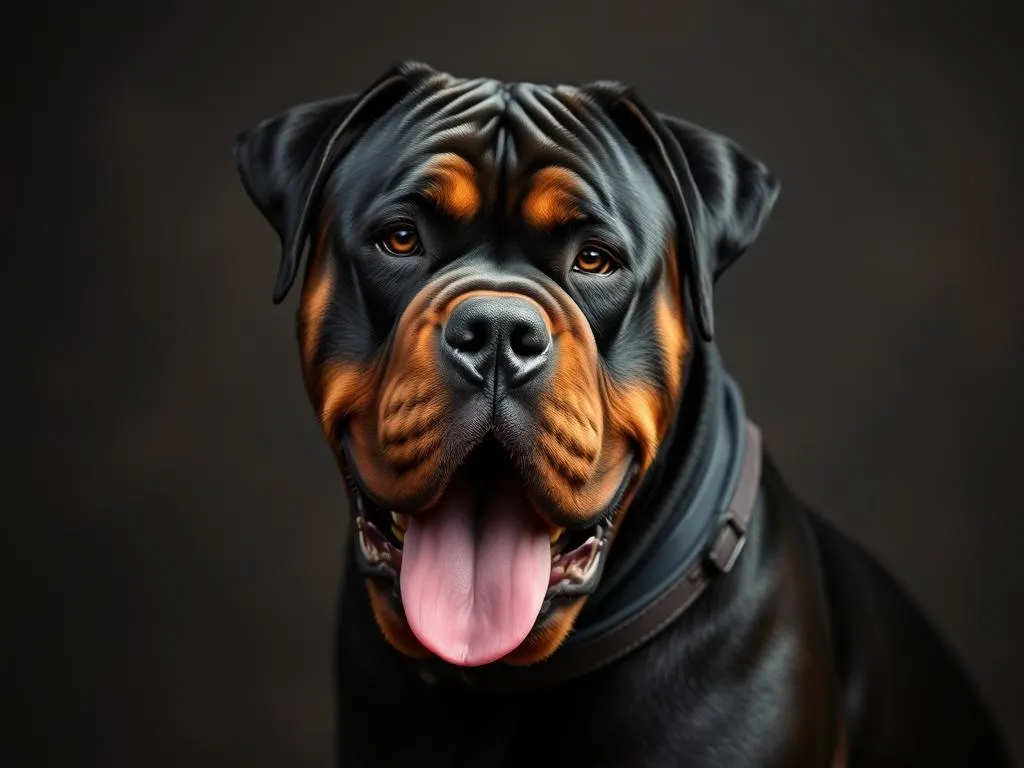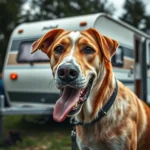
Introduction
When it comes to unique and fascinating dog breeds, the Rott Pei, a crossbreed between the Rottweiler and the Shar Pei, stands out. Each of these parent breeds carries its own rich history, distinct physical characteristics, and temperamental traits. Understanding these breeds is essential for anyone considering bringing a Rott Pei into their home. As mixed breeds become increasingly popular, it’s crucial to grasp what makes them special, as well as the potential challenges they may present. In this article, we will delve into the intricacies of the Rott Pei, exploring its origins, physical and behavioral characteristics, care needs, and more.
Understanding the Parent Breeds
Rottweiler
Origin and History
The Rottweiler has roots tracing back to ancient Rome, where they were used as herding and guarding dogs. They were later bred in Germany, where they took on a role as protectors of livestock and property. Known for their loyalty and strength, Rottweilers became popular in various working capacities, including police and service dog roles.
Physical Characteristics
Rottweilers are stocky, muscular dogs with a robust build. They typically weigh between 80 to 135 pounds and stand about 22 to 27 inches tall at the shoulder. Their coat is short, dense, and usually black with distinct tan markings.
Temperament and Behavior Traits
Rottweilers are known for their unwavering loyalty and protective instincts. They are confident, intelligent, and can exhibit a calm demeanor if properly trained and socialized. However, they can also be wary of strangers, making them excellent watchdogs.
Common Health Issues
Despite their strength, Rottweilers are prone to certain health issues, including hip and elbow dysplasia, heart problems, and certain types of cancer. Regular veterinary check-ups and a healthy diet can help mitigate these risks.
Shar Pei
Origin and History
The Shar Pei originated in China, where they were initially bred for hunting and guarding. Their unique wrinkled appearance and distinctive blue-black tongue have made them a culturally significant breed in their homeland. Over the years, Shar Peis have transitioned from working dogs to beloved family pets.
Physical Characteristics
Shar Peis are medium-sized dogs, typically weighing between 40 to 65 pounds and standing about 18 to 20 inches tall. They are best known for their loose, wrinkled skin, which gives them a distinctive look. Their coat is short, bristly, and comes in various colors, including fawn, cream, and chocolate.
Temperament and Behavior Traits
Shar Peis are known for their independent and sometimes stubborn nature. They are loyal and protective, often forming strong bonds with their families. Early socialization is crucial to prevent aloofness towards strangers.
Common Health Issues
Shar Peis can be susceptible to skin conditions due to their unique folds, as well as hip dysplasia and respiratory issues. Regular grooming and monitoring of their skin can help keep them healthy.
The Rott Pei: An Overview
What is the Rott Pei?
The Rott Pei is a crossbreed that combines the strength and loyalty of the Rottweiler with the unique appearance and independent spirit of the Shar Pei. This mix has gained popularity among dog lovers who appreciate the qualities of both parent breeds.
Popularity and Recognition
While the Rott Pei is not recognized by major kennel clubs, its growing popularity is evident in various pet communities and social media platforms. Many owners are drawn to the unique characteristics of this hybrid, making it an appealing choice for families and individuals alike.
Physical Characteristics
Rott Peis generally inherit a blend of features from both parent breeds.
- Size and Weight Range: They typically weigh between 50 to 90 pounds and stand about 18 to 26 inches tall.
- Coat Type and Color Variations: The coat can vary, often being short and dense, resembling the Rottweiler’s with the potential for Shar Pei-like texture. Colors can range from black to various shades of fawn and brown.
- Distinctive Features: One of the most notable characteristics of the Rott Pei is its wrinkles, inherited from the Shar Pei, which add to its unique appearance.
Temperament
The temperament of a Rott Pei is heavily influenced by the traits of its parent breeds. Generally, Rott Peis are known to be:
- Loyal and Protective: They tend to form strong bonds with their families and can be protective of their loved ones.
- Intelligent and Trainable: Both parent breeds are intelligent, making Rott Peis capable of learning commands and tricks.
- Independent: Like the Shar Pei, Rott Peis may exhibit independent behavior, requiring patient and consistent training.
Care and Maintenance
Diet and Nutrition
A well-balanced diet is essential for maintaining the health of a Rott Pei.
- Recommended Diet: High-quality dog food formulated for large breeds is ideal. Look for options with real meat as the primary ingredient and limited fillers.
- Food Allergies and Sensitivities: Be mindful of potential allergies, especially to grains and certain proteins. Monitor your dog for any signs of food intolerance.
Exercise Requirements
Rott Peis are active dogs that require regular exercise to keep them healthy and happy.
- Exercise Needs: Aim for at least 60 minutes of exercise daily, which can include walks, playtime, and training sessions.
- Types of Activities: Engage in activities like fetch, agility training, or obedience classes, which can provide physical and mental stimulation.
Grooming Needs
Grooming is essential to keep a Rott Pei looking and feeling its best.
- Shedding and Coat Care: Rott Peis may shed moderately, so regular brushing will help manage loose hair and keep the coat healthy.
- Bathing and Grooming Frequency: Bathe as needed, typically every few months, to keep the skin healthy. Regularly check and clean the wrinkles to prevent skin infections.
Health Care
Regular veterinary check-ups are crucial for early detection of health issues.
- Common Health Concerns: Be vigilant about potential health issues like hip dysplasia, skin conditions, and obesity. Regular exercise and a balanced diet can help mitigate these concerns.
Training and Socialization
Importance of Training
Training is vital for all dogs, especially for Rott Peis, to ensure they are well-behaved and manageable.
- Why Training is Crucial: Training fosters a strong bond between owner and dog, helps establish boundaries, and reduces behavioral issues.
- Basic Commands to Teach: Focus on essential commands such as sit, stay, come, and heel. Consistency is key.
Socialization Techniques
Socialization is crucial for preventing behavioral problems and ensuring a well-adjusted pet.
- Importance of Socializing During Puppyhood: Expose your Rott Pei to different environments, people, and other animals during its early months.
- Recommended Socialization Methods: Consider puppy classes, dog parks, or arrange playdates with other dogs to enhance social skills.
Behavioral Issues
Like all breeds, Rott Peis can exhibit behavioral issues if not properly trained and socialized.
- Common Behavioral Problems: Potential issues include stubbornness, aggression towards unfamiliar dogs, and separation anxiety.
- Solutions and Tips for Correction: Address problems early with positive reinforcement training and consistent boundaries.
Living with a Rott Pei
Ideal Living Environment
The living environment can significantly impact a Rott Pei’s well-being.
- Best Living Situations: Rott Peis thrive in homes with space to roam, making them better suited for houses with yards than apartments.
- Space Requirements: They need room to exercise and play, so a secure yard is ideal.
Compatibility with Children and Other Pets
Rott Peis can be excellent family dogs when properly trained and socialized.
- General Behavior Around Children: They are typically gentle and protective with children, forming strong bonds.
- Interactions with Other Dogs and Pets: Early socialization can help them get along with other pets. Monitor interactions to ensure everyone’s safety.
Pros and Cons of Owning a Rott Pei
Advantages
Owning a Rott Pei comes with several benefits:
- Unique Traits and Benefits: Their distinct appearance and blend of characteristics from both parent breeds make them fascinating companions.
- Loyalty, Protection, and Companionship: Rott Peis are known for their unwavering loyalty and protective nature, making them excellent family guardians.
Disadvantages
However, potential owners should also consider the challenges:
- Potential Challenges and Drawbacks: Rott Peis may require more training and socialization than other breeds, especially due to their independent nature.
- Breeding Concerns and Breed-Specific Issues: Be aware of potential health issues that can arise from mixed breeding, and choose reputable breeders or shelters.
Conclusion
The Rott Pei is a captivating crossbreed, combining the strength and loyalty of the Rottweiler with the unique appearance and independence of the Shar Pei. Understanding their characteristics, care needs, and training requirements is vital for any potential owner. If you’re considering adding a Rott Pei to your family, be sure to conduct further research and consider the responsibilities that come with dog ownership. This unique breed can offer companionship, protection, and love, making them a valuable addition to the right home.
FAQs
What is the lifespan of a Rott Pei?
Rott Peis typically live between 10 to 15 years, depending on their health, diet, and care.
Are Rott Peis good with kids?
Yes, when properly trained and socialized, Rott Peis can be gentle and protective companions for children.
How much exercise does a Rott Pei need?
Rott Peis require at least 60 minutes of exercise daily to meet their physical and mental needs.
What is the cost of owning a Rott Pei?
The initial cost of a Rott Pei can vary widely, generally ranging from $500 to $2,000, plus ongoing expenses for food, grooming, and veterinary care.
Can Rott Peis be left alone for long periods?
While Rott Peis can tolerate being alone for a few hours, they thrive on companionship and should not be left alone for extended periods, as they may develop separation anxiety.









